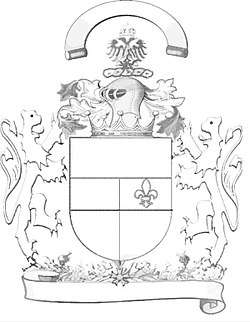List of heraldic charges
This is a list of heraldic charges. It does not cover those charges which are geometrical patterns and resemble partitions of the field; for these, see Ordinary (heraldry).
"Subordinary" charges
.svg.png)
A few simple charges are traditionally, and arbitrarily, classified among the so-called subordinaries. (All other mobile charges are called common charges.)
- lozenge
- fusil (a narrow lozenge)
- mascle (lozenge voided)
- rustre (lozenge pierced)[1]
- billet[1][2] (a rectangle)
- annulet (a ring)
- roundel, but different tinctures have different names: for example roundels argent are called plates. A roundel barry wavy azure and argent is called a fountain.
- label is commonly a mark of difference, but also appears as an independent charge.
- fret: originally woven from three bendlets (dexter) and three bendlets sinister, now usually a single bendlet each way interwoven with a mascle.[1]
Human figures
- Infants and newborns
- The child, by default, is depicted as a boy
- In the arms of Kajiado County, Kenya, one of the children has a shaved head[3]
- A man, by default, is depicted as bearded and European, with other types or ethnicities distinguished.
Parts of human bodies
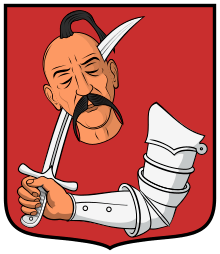
- The head
- The hand, or hand and arm, is the most common part of the human body to be a charge.[1]
- The ear[5]
- Feet[6]
- Teeth
- Tongue[7]
- The heart, even when blazoned "a human heart", always appears like the heart in a deck of cards rather than a natural human heart.
- A "dug" or woman's breast "distilling drops of milk" famously appears in the arms of the Dodge family, and appeared for a time on the badge of cars made by the Dodge Automotive company.[8]
- Beards[9]
- Testicles: the Neapolitan family of Coglione bore per fess argent and gules, three pairs of testicles counterchanged.[10] The similar coat of the Counts Colleoni of Milan is sometimes blazoned Per pale argent and gules, three hearts reversed counterchanged.[11]
Beasts
Any animal can be a heraldic charge, although more traditional ones vary in the exactitude with which they resemble the creature as found in nature. Animals depicted naturally are either described as natural or using the scientific nomenclature.
Predatory beasts
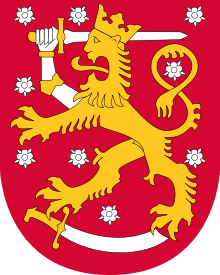
- Felines
- The lion.
- The heraldic tyger is an imaginary monster; where the natural beast appears it is blazoned as a Bengal tiger.[1][12]
- A leopard refers to a lion "passant guardant", rather than a natural leopard, in the languages of French and English heraldry. A leopard's face also occurs, sometimes jessant-de-lys.[1]
- A heraldic panther is usually depicted spitting fire
- The (domestic) cat, distinguished from the wild cat or "cat-a-mountain"
- Canines
- Fox
- Hound (dog). The two most common breeds are the talbot (dog) and greyhound.[1]
- Wolf
- Bear
- Brock or (badger)
- Weasels such as the Ermine (stoat)
- Otter[1]
- Thylacine
Ungulates
- Antelope, usually blazoned as a specific type unless it is the mythical heraldic antelope.
- Cattle Bulls, cows or calves.
- Camel
- Deer usually a red deer, also called a hart or Stag, and the Buck denotes a Fallow deer. Females are called hinds or does.[1]
- Elephant; sometimes with a castle or seat on its back.
- Equines such as the ass and the horse sometimes of a specified breed and the mythical Unicorn[1] and Pegasus.
- Hippopotamus
- Rhinoceros
- Swine either wild boars or domestic pigs
- Sheep and Goats Including Rams, ewes, lambs, ibex and Agnus Dei
Other mammals
Reptiles and amphibians
- The serpent usually depicted nowed.[1]
- The salamander is typically shown as a generic lizard, sometimes with a head of unusual shape often described as "dog-shaped", and always surrounded by flames.
- The lizard
- The Biscione
- Dragon: by default a European one, but also a Chinese dragon.[17]
- Tortoises and Turtles
Insects
Insects include:
- Bee, often flying around beehives, natural or man-made
- Butterfly
- Dragonfly
- Emmet (heraldry)
- Flea
- Fly
- Grasshopper
Combination animals
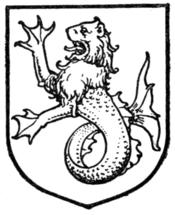
In heraldry
- Sphinx: depicted with the head and breasts of a woman.
- Griffin, combining the head (but with ears), chest, wings and forelegs of the eagle with the hindquarters and legs of a lion (the male griffin lacks wings and his body is scattered with spikes). See List of griffins as mascots and in heraldry.
- Unicorn, having a horse's body, deer's legs, goat's beard, and often a lion's tail
- The hippogriff is like the griffin except that the lion parts of the griffin are replaced by those of a horse.
- Harpy
- Theow is a wolf-like creature but with cloven hooves.
- The "seahorse" (hippocampus) is depicted as half horse and half fish
- The sea-lion is a combination of a lion and a fish.[1]
- Any combination of parts of other animals, e.g. winged reindeer, is possible.[1]
Birds
By far the most frequent heraldic bird is the eagle. A variant is the alerion, without beak or feet, seen in the arms of the duchy of Lorraine (for which it is an anagram).
Also very frequent is the martlet, a conventional swallow depicted without feet or the French variant the merlette, which also omits the beak.
- Auk[18]
- Cock
- Cockatoo
- Cormorant
- Corvus
- crane
- Dove
- Duck without beak or legs is called the merlette
- Eagle, usually displayed, i.e. with wings spread
- Alerion: eagle without beak or feet
- Double-headed eagle
- Triple-headed eagle
- Emu
- Falcon
- goose
- Gull or seagull
- Hawk
- Heron
- Kiwi
- Kookaburra
- Magpie: Otton de Cazeneuve bore "Or, three magpies sable" at Falkirk.
- Martlet
- Osprey: almost invariably depicted simply as an eagle argent, often maintaining (holding in its talons or beak) a fish
- Ostrich or its feathers
- Owl
- Papingo or Popinjay (parrot).
- Pelican, sometimes with its young.[19]
- Peacock often blazoned in its pride
- Phoenix
- Stork[20]
- Swan
- Turkey cock: was a later immigrant from the New World
- Egg: rare.
Fish and creatures of the sea
"Fish" are sometimes only described as "a fish", but the species is often named:
- Carp
- Catfish[21]
- Cod
- Conger
- Cuttlefish
- Dolphin[1]
- Eel
- "Garvine fishes", in canting contexts[22]
- The pike, also called a ged or Lucy[1]
- Perch
- Roach
- Salmon
- Sturgeon
- Herring
- The "seahorse" is depicted as half horse and half fish, but if the natural seahorse is to be depicted it is blazoned as a "seahorse (hippocampus)".
- The whale[1]
- The escallop (scallop shell)
- Mullet
- Mussels appear in the arms of Musselburgh in Scotland.[1]
- Whelk shell
- Mermaid and Melusine
- Octopus
- Squid
Parts of animals
Parts of creatures may also be used as charges.
Plants
Flowers
- The fleur-de-lis
- Heraldic roses are shown in a stylised form similar to the wild rose. A rose on top of another rose form a double rose.
- though there are several unusual different types blazoned, such as the Luther rose.
- White Rose of York; Red Rose of Lancaster; Tudor Rose, which is a double rose.
- The lotus flower
- The thistle
- Other commonly used flower-like charges (called "foils") include:
- Trefoil (with three petals; usually slipped, with a stem)
- Quatrefoil (with four petals)
- Cinquefoil (with five petals)
- Sexfoil (with six petals)
- The septfoil (with seven petals)
- The double quatrefoil (with eight petals)—in England the rare cadency mark of a ninth son.
- Strawberries and the strawberry flowers depicted as cinquefoils
- Grapevines
Trees and their fruits
Trees appear as eradicated (showing the roots) or couped. Fruit can appear on a tree, or by itself. Also, leaves and branches appear.
- Tree trunk
- Apple tree
- Cherry
- Pears (with peartrees)[23]
- Coffee, including branches and beans
Other flora
- Maple leaf - symbol of Canada
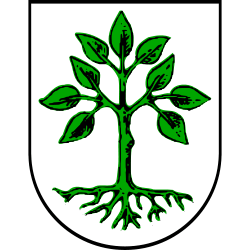
Trees are sometimes merely blazoned as "a tree" but specific trees are mentioned in blazon.
- The oak and the acorn
- The pines and the pine-cone also called a pineapple.
- elm
- poplar, also called aspen
- willow, also called Salix or Osiers; its branch is called a wand
- alder
- coconut tree
- palm
- Laurel trees
- olive
- The pomegranate tree
- cannabis
- grass, often on a mound
A small group of trees is blazoned as a hurst, grove, wood or thicket.[2]
Grain crops and vegetables

Inanimate charges
Celestial bodies and atmosphere
- A sphere[28] in an orbit.
- A sun with rays is called a sun in splendour.
- Moons come in various phases, including crescent and "in her plenitude" (a full moon with a face).
- Mullets represent stars or spur rowels. Stars can have any number of points, but if nothing is specified in the blazon it is usually five or six.
- Estoiles are stars with wavy rays; pole stars are differentiated.
- Constellations such as the Southern Cross.
- Magen David
- Astrological symbols such as Taurus
- clouds
- An atomic cloud[29]
- A cumulo nimbus cloud [sic] in the arms of the 362d Fighter Group of the United States Air Force[30]
- A stylized cloud formation in the arms of the 23rd Air Division of the United States Air Force
- A tornado in the arms of the 311th Fighter Group of the United States Air Force[31]
- The planets such as Jupiter and Saturn and their moons. Saturn is always depicted with its rings.
- The armillary sphere or globe[2]
- Lightning bolts, also called "lightning flashes", are shown in a stylized way.
- Thunderbolts, shown in a stylized way
- volcano
- A mount or a trimount.
- A glass throughout, shattered, argent[32]
- The wheel is a carriage wheel unless otherwise specified
- A winged wheel
- Catherine Wheel
- A millwheel or water wheel
- Cogwheel (used mainly in more recent coats-of-arms to represent heavy industry)
- Emblem of the Trinity[33]
- Letters of the Greek and Latin alphabets, often with religious themes
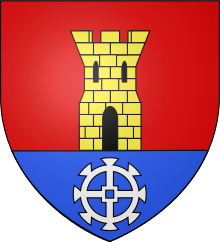
Ships and boats

- The lymphad (a type of ancient ship)
- A Roman ship
- Viking ships
- Three-masted sailing ships
- A barque
- Anchor
Structures
- Religious Structures
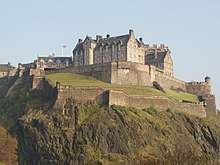
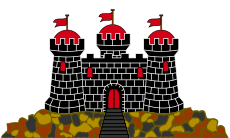
- Fortified buildings
- Castle, a castle of the generic type consists of two towers connected by an embattled wall (also a charge in heraldry).[1] Varieties occur, such as being triangular or quadrangular. Also, the windows and doors can be of a different tincture, as well as the masonry. Sometimes they have domed towers.
- Towers can be combined with castles or have their own towers. They vary in the same way as castles.
- Portcullis[1]
- Columns
- Arches
- Mills, e.g. windmills[1]
- Dovecotes
- Tents[19]
Headgear
- Phrygian cap
- Mitre[2]
- Crowns or coronets, if not more precisely specified, have four leaves (three visible) and no arches. Varieties include:
- naval crown[2]
- Royal Crown
- Imperial crown
- civic crown[2]
- Eastern crown or Antique crown[2]
- camp crown, crown vallary or crown palisado[2]
- mural crown[2]
- Crancelin, a crown of rue[2]
- Papal tiara
- Helmets
Music
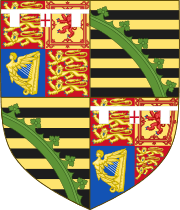
Musical instruments include:
Weapons
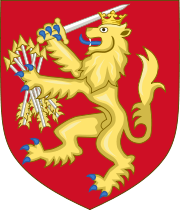
- Axes of various types
- Battering ram[19]
- Bow, including the longbow and crossbow, and arrow[2]
- Caltrop, displayed with one spike pointing upwards
- Cannon, including the culverin[1]
- Grenade: similar in appearance to a cannonball with flames coming out of a flattened end.[1]
- Lance and spear sometimes broken, usually of the tilting variety.[2]
- Mace[2]
- Musket[37]
- Sword, including variants such as the scimitar, seax, and dagger[1]
- Pennon, often referred to as a pile (military construction beam) or passion nail (tool); a type of flag used to signal battle commands.[38]
Tools
- Anvil[1]
- Fetterlock[1]
- Fire brand[1]
- Fire striker[1]
- Fleam[1]
- Hammers, of various types[1]
- Harrow[19]
- Keys[1]
- Millrind[1]
- Nails, often passion nails[1]
- Shovel
- Sickle
- Ladders typically take the form of scaling ladders.[1]
- Rake
- Scales (weighing)
- Shuttle[1]
- Surgeons' scalpels
- Trowel
- Tun[19]
- Water-bougets A charge resembling the water bags that were used to supply the army in battle[19]
Clothing and other personal items
- Buckles in a variety of styles even in the form of a heart.[39]
- The maunch is a lady's stylized sleeve.[1]
- Spurs.[1]
- chamber pots[40]
- Chess rooks
Notes
- 1 2 3 4 5 6 7 8 9 10 11 12 13 14 15 16 17 18 19 20 21 22 23 24 25 26 27 28 29 30 31 32 33 34 35 36 37 38 39 Fox-Davies, Arthur Charles (1909). A complete guide to heraldry (1909). New York : Dodge. Retrieved 2013-08-21.
- 1 2 3 4 5 6 7 8 9 10 11 12 13 14 "Heraldsnet.org". Heraldsnet.org. Retrieved 2010-08-16.
- ↑ http://ngw.nl/heraldrywiki/index.php?title=Kajiado_county. Retrieved 2018-05-26. Missing or empty
|title=(help) - ↑ http://heraldry.com.ua/index.php3?lang=E&context=info&id=1122#verh. Missing or empty
|title=(help) - ↑ http://armorialdefrance.fr/page_blason.php?ville=2650. Missing or empty
|title=(help) - ↑ "Blasoneshispanos.com". Blasoneshispanos.com. Retrieved 2010-08-16.
- ↑ "NGW.nl". NGW.nl. Retrieved 2010-08-16.
- ↑ Martin Goldstraw. "Cheshire-Heraldry.org.uk". Cheshire-Heraldry.org.uk. Retrieved 2010-08-16.
- ↑ "Zeljko-heimer-frame.from.hr". Zeljko-heimer-fame.from.hr. Retrieved 2010-08-16.
- ↑ "Sex in Heraldry". Heraldica.org. 1997-06-26. Retrieved 2010-08-16.
- ↑ John Woodward and [[George Burnett (officer of arms)|]], A Treatise on Heraldry, British and Foreign, page 203
- ↑ "NGW.nl". NGW.nl. Retrieved 2010-08-16.
- ↑ http://ngw.nl/heraldrywiki/index.php?title=Cenotillo. Retrieved 2018-05-13. Missing or empty
|title=(help) - ↑ "Heralrdy.ca". Heraldry.ca. Retrieved 2010-08-16.
- ↑ From "Jack of Naples" (Jac-a-Napes), later (early modern period) reanalyzed as "jack-an-apes", taking "apes" as "ape, monkey". Monkeys were one of many exotic goods from Naples exhibited in England, hence acquired the nickname Jack a Napes (first attested 1450).
- ↑ Charles Norton Elvin, Dictionary of Heraldry, 1889, plate 29, nos. 57–59. The monkey as heraldic animal remained comparatively rare, but it is on record from as early as the 14th century, as in the Affenstein crest from the Zürich armorial (c. 1340).
- ↑ "College-of-arms.gov.uk". College-of-arms.gov.uk. Retrieved 2010-08-16.
- ↑ "Heraldsnet.org". Heraldsnet.org. Retrieved 2010-08-16.
- 1 2 3 4 5 6 Jacqueline Fearn. Discovering Heraldry. Shire Publications. pp. 40–41.
- ↑ "NGW.nl". NGW.nl. Retrieved 2010-08-16.
- ↑ Gerard Michon (2004-06-19). "Numericana.com". Numericana.com. Retrieved 2010-08-16.
- ↑ Balfour Paul, James (1893). An Ordinary of Arms Contained in the Public Register of All Arms and Bearings in Scotland. William Green and Sons. pp. 108–109.
- ↑ "Heraldsnet.org". Heraldsnet.org. Retrieved 2010-08-16.
- ↑ "College-of-arms.gov.uk" (PDF). Retrieved 2010-08-16.
- ↑ Books.Google.com. Books.Google.com. 2006-06-12. Retrieved 2010-08-16.
- ↑ {{cite web|url=http://zeljko-heimer-fame.from.hr/descr/hr-vz2.html%7Caccessdate=2018-05-27))
- ↑ "College-of-arms.gov.uk" (PDF). Retrieved 2010-08-16.
- ↑ In the arms of the 91st Bombardment Group of the United States Air Force.Air Force Combat Units of World War II. p. 158.
- ↑ Shown in the coats of arms of several units of the United States Air Force, such as the 508th Fighter Group.Air Force Combat Units of World War II. p. 371.
- ↑ Air Force Combat Units of World War II, p.246
- ↑ Air Force Combat Units of World War II. p. 187.
- ↑ Air Force Combat Units of World War I, p.154
- ↑ A Complete Guide to Heraldry by A.C. Fox-Davies and J.P. Brook-Little (1969 edition), p. 212.
- ↑ Cundinamarca.gov.co
- ↑ Heraldsnet.org
- ↑ Heraldica.org
- ↑ Heraldsnet.org
- ↑ Journal of the British Archaeological Association, Volume 13. British Archaeological Association., 1857 - Archaeology, Page 119
- ↑ Balfour Paul, p. 41
- ↑ Heraldica.org
External links
- NGW.nl, List of heraldic charges (with images)
- A Heraldic Primer, SCA College of Arms on the Web
